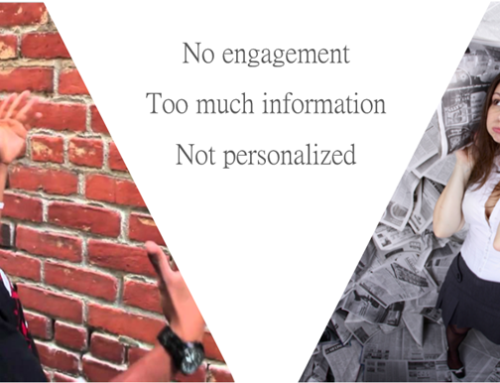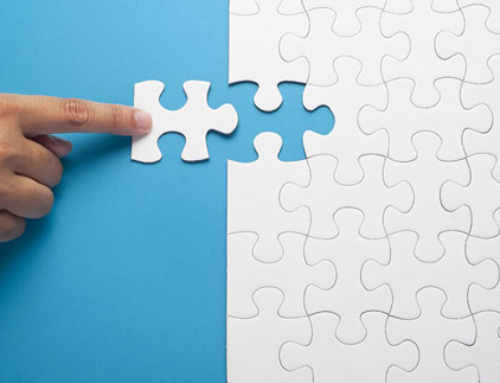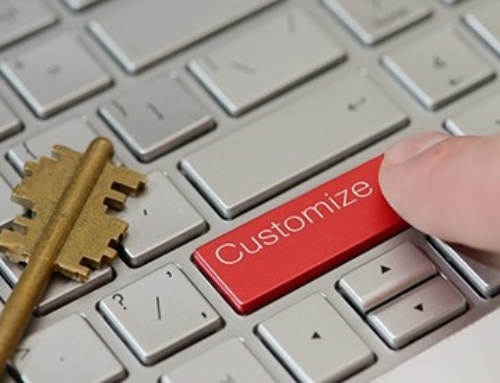BY ADMIN – POSTED IN CONTENT MARKETING ON 19 MAR, 2018
Marketing has evolved considerably over time. From printing press and simple ads to the digital world, today’s marketer relies heavily on data analytics and personalization. Personalization is no longer a buzz word because those who know of its importance are capitalizing it and reaping the benefits. Thanks to predictive analysis and cloud marketing solutions, most organizations today are able to personalize content on social media and e-commerce channels.
Personalization essentially means interacting with a customer through content or software in a way that makes them feel that their interests are being taken into account. Companies tailor content for individual users depending on their characteristics and preferences, gauged through data collection, analysis and automation technology. Personalization can be considered a key element to increase both revenue and customer base because it allows a company to segment its consumers and target them accordingly.
The extent to which personalization is being used today can be understood in greater detail thanks to a famous incident that happened at Target. In the article, How Companies Learn Your Secrets, the author, Charles Duhigg, tells about a father who was angry at a Target store for sending his daughter coupons related to baby products. His daughter was, in fact, pregnant and the retailer was able to predict it.
Target was able to predict this by tracking the girl’s buying behavior. Every customer is assigned a Guest ID number when they first buy a brand. That ID then collects all information regarding demographics, psycho graphics and buying preferences. This information allowed marketing analysts to figure out that the girl was expecting. Although the incident comes off as a bit creepy, it shows the power of data analytics and right information.
Today, personalization is more important than ever as consumers have access to content from a plethora of channels. Among this overload of information, personalized content manages to attract consumers’ interest. While all other information hits them in the face and still gets ignored, personalized content talks directly to them.
This behaviour can be explained scientifically. According to a study published in Brain Research, when people hear their own name, there is a unique reaction in the brain. More specifically, middle and superior temporal, which are associated with long-term memory, are triggered. A similar reaction takes place in the brain when people get personalized content. They tend to remember it for much longer too.
Furthermore, a study by University of Texas shows that personalized experiences basically help consumers in two ways: desire for control and information overload. Tailored content makes us feel that we have some control over what we wish to see and it saves us from information overload. According to Lewis, the CMO of Johnson & Johnson, “Content needs are exploding as we move to a world of precision marketing and 24/7 engagement.”
Here are some ways companies can benefit from personalization:
- Improved customer experience
Today, more consumers are willing to share their data with companies to get personalized experiences. They fill out forms and participate in surveys and expect the brands to protect this information.
According to a research conducted by Salesforce on 7,000 consumers, information bombardment method does not work on consumers anymore. In fact, consumers revealed that they equate personalization with the company’s reputation. 58 per cent of consumers said that personalization is an important factor in determining purchase intention, while an almost equal number of the respondents said that a well-reputed brand is important.
The study also showed that 57 per cent of consumers are willing to exchange personal data in return for tailored offers and discounts. Also, 52 per cent said that they are willing to receive product recommendations.
Yet, another study conducted by Dive shows that 44 per cent of consumers are willing to share their personal information in return for ads tailored to their needs. The study also revealed that people are twice likely to click through for an unknown brand if the ad is personalized.
However, brands need to ensure they don’t overwhelm the consumers with information. It is more important to develop and maintain a relationship. You need to keep reminding them about your product, but in a subtle manner. You need to engage a potential consumer until they are ready to purchase your product. So, if a consumer visits your website looking for something, send them an email with more details.
- Increase in revenue
A marketer’s job doesn’t end once they have attracted a customer to their company’s website or store. Their goal should be to increase customers’ lifetime value, and personalized messages based on previous purchasing behavior is the key. Companies can increase their return on investment by identifying which channels customers prefer the most and following up on them.
This is not only relevant in the B2C market, but also in a B2B market. B2B marketers can create personalization by dividing their customer base according to industry, size, revenue, and location. 70% of buyers say that the seller’s website is the most influential channel in their purchase, which means if sellers are able to customize their websites, then their websites can increase sales.
Personalization is not only restricted to online experience. In-store personalization also plays an important part in driving sales. 75 per cent of US retailers believe that personalized shopping experience will be important for their business in the near future. Also, 46 per cent of customers are likely to purchase something if a retailer customizes the shopping experience.
Another survey conducted by Accenture shows that one in two consumers will shop at a retailer that knows them by name and two in three will shop if the retailer knows their purchase history. A Perish analysis of 380 CMOs by Forbes also shows that personalized web experiences get double digit growths in marketing performance and response.
Personalization combined with loyalty programs, shopper events, sales promotion and signage can really boost a retailer’s revenue. Other than that, sales people can play an important part in increasing revenue.
44 per cent of consumers believe that an informed sales person can really improve their shopping experience. Feedback is perhaps the best way to personalize because customers feel special and appreciate when their opinion on the products or services is taken into account.
- Increases customer retention
Acquiring a new customer can cost a lot more than retaining an existing one. However, retaining customers is also not a piece of cake. With growing competition and a number of choices available to consumers, switching costs have gone down and customers usually don’t wait before jumping the ship. According to a Harvard Business Review, increasing customer retention rates by 5% increases profits by 95%. Personalized marketing is one tool that can help marketers retain customers.
One way to re-engage customers is by segmenting them based on their last visit. Once you have done that, you can send customers, who haven’t visited in a while, a personalized email or a tailored newsletter with recommendations. Also, you can give them the option to save their abandoned carts by emailing them later. Moreover, you can also give them discounts and coupons to make them return to your brand.
It’s also a good idea to reward your frequent customers. In fact, you should come up with creative ways of rewarding them. Free delivery can be a great option to entice consumers. Another way can be inviting them to events, sending them free samples for new products and asking for their opinion.
- Increases brand loyalty
The less tangible benefits of personalization help you create brand loyalty and love for your brand. Through personalization, you can talk to different audiences and yet keep the core of your brand intact.
As per a study by Swirl, 87 per cent of the consumers surveyed said that more personalized experiences, both online and in-store, would increase brand loyalty. Also, a consumer behaviour report by Harvard Business Review shows that two-thirds of consumers remain loyal mainly because they feel shared values with the brand.
The example of Coke is quite relevant here. Coke launched its ‘Share a Coke’ campaign in 2014. It circulated over 800 names, which covered around 77% of the US population. It also gave its customers an opportunity to customize their bottles. Coco Cola played a smart move. Keeping its young target audience in mind, it gave them something fun and shareable that encouraged them to actively participate in the campaign with their friends.
Amazon is yet another great example when it comes to personalization. It uses purchase history and recommends purchases. It also uses personalization tokens and sends frequent emails to potential buyers.
Moreover, it utilizes shipping address and recommends products based on your location. Such personalization induces repeat purchase. When customers feel that a brand takes care of their preferences, they are more likely to stick with it.
The demand for personalization is increasing exponentially thanks to technology which has made personalization a lot easier. Also, marketers are coming up with new and innovative ways to interact with their consumers. The first and foremost step in personalization is asking the right questions. Once you know customers’ motivations behind visiting your store or website, you can segment them accordingly. One way to collect information is through sign-up forms.
Data about consumers’ location and time can also prove to be quite useful, especially when it comes to email marketing. Certain times of the day proves to be better than others. Some customers might like getting emails at 5 pm when they are free instead of 8 am when they are caught up with work. You can always use A/B testing to find that out.
If you have customers from different parts of the world, you also need to take care of time zones. You can also utilize marketing automation to send behavioral trigger emails. These emails are sent automatically depending on a consumer’s behavior. For example, if you haven’t used a fitness app in a while, this behavior will trigger an email.
Apart from targeted emails, you can also send consumers custom video messages about their likes. A video is more likely to interest consumers and keep them engaged. Facebook is a great example when it comes to such personalization. Facebook’s birthday and ‘friendversary’ videos are popular among its users. These videos give them a special feeling and keep them on the platform.
Product recommendations are another great way to entice consumers. They are especially ideal for e-commerce websites that often give suggestions based on their users’ past behaviors. These suggestions make it easier for users to sift through the site thereby increasing their chances of a purchase.
Apart from that, you can work on your website and make it more customized for users, particularly if you are in a B2B business. You should divide your audience in segments and then determine the needs of each segment at each stage of the business cycle. Subsequently, you can create appropriate content for every stage. This process also gives you the opportunity to up-sell your products.
There are always challenges associated with personalization because there is no magic formula that will make it right. At best, they are educated guesses about what your consumers want. [NOTE: With BlenderConnect personalization moves from educated guesses to a real-time engagement with the customer to capture what they want – making the personalization perfectly targeted because it is in real-time and current.]
Hence, it would be better if you adopt a conservative approach with your recommendations, especially if you have just started them. The best way is to test your algorithms on a small batch, which can be your most active users. You can seek out your frequent users and ask them to test anything new that you are planning to come up with.
The idea behind personalization is to make your customers know that you care about their choices and preferences. However, there is a difference between personalization and being creepy. An ideal personalization strategy should not intrude in the lives of consumers and make them feel as if their privacy is being violated.
If consumers feel a brand is being too pushy, they are more likely to unfollow it. Always try to keep yourself in the shoes of the customers and try to think from their perspective. Personalization helps consumers discover new things and often leads to unplanned purchases. When executed correctly, personalization can have a great impact on your bottom line.




